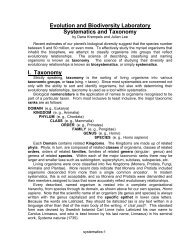Biodiversity in Plants What influences species richness? Tropics vs ...
Biodiversity in Plants What influences species richness? Tropics vs ...
Biodiversity in Plants What influences species richness? Tropics vs ...
Create successful ePaper yourself
Turn your PDF publications into a flip-book with our unique Google optimized e-Paper software.
Regional Pool & Local Species Richness!%.%+"9'*"K%+.'05'-0+%'+%4,0."9'$*%7,%$'+%$#9/$',.'-0+%'907"9'$*%7,%$C'D,99'A0#'4%/'-0+%'907"9'$*%7,%$'"$'A0#'%F09F%'-0+%'+%4,0."9'$*%7,%$L'Regional Pool & Local Species Richness!%.%+"9'*"K%+.'05'-0+%'+%4,0."9'$*%7,%$'+%$#9/$',.'-0+%'907"9'$*%7,%$C'D,99'A0#'4%/'-0+%'907"9'$*%7,%$'"$'A0#'%F09F%'-0+%'+%4,0."9'$*%7,%$L'<strong>Tropics</strong> <strong>vs</strong>. TemperateDisturbance and environ heterogeneity•! More ecological niches•! Intermediate Disturbance•! Herbivore and Pathogen•! Random ecological drift•! Number of <strong>species</strong> covary with habitat heterogeneity•! Disturbance results <strong>in</strong> a mosaic of habitats
Connel’s Intermediate Disturbance HypothesisConnel’s Intermediate Disturbance Hypothesis•!Moderate levels of disturbance results <strong>in</strong> a mosaic of habitat patches whichallow coexistence of many <strong>species</strong>•! Applies to coral’s too•! Intermediate habitatsshow greatest diversityM**9,%E'/0'J+0*,7$C',$'E,$/#+G".7%',$'4+%"/%+L'Connel’s Intermediate Disturbance HypothesisPest-Herbivore Pressure Hypothesis•!Contrary Results. No pattern with gaps/disturbances and <strong>species</strong> richesacross time (Hubbell et al. 1999, Barro Colorado Island, Panama)•!Pest/parasites attack most common, dom<strong>in</strong>ant <strong>species</strong> = opens upopportunities for rarer, less “attractive” <strong>species</strong> to persist
Pest-HerbivorePressure Hypothesis-! Th<strong>in</strong>n<strong>in</strong>g<strong>in</strong>creased survival-! Removal ofpathogens<strong>in</strong>creased survivalBut is this differentbetween tropics andtemperate?Not known….Hubbell’s Random Ecological Drift-! Past 50 to 60 years, explanations of diversity have been focusedon niches-! <strong>What</strong> if diversity is simply random processes.-! Hubbel’s model:1. Pest pressure and recruitment limitations reduces <strong>in</strong>terspecificcompetition (self limitation). Most tropical trees are thuscompetitively similar2. Instead of th<strong>in</strong>k<strong>in</strong>g of a community as populations with verydifferent niches and abilities, populations are functionallyequivalent (equal/similar per capita vital rates)3. Individuals of all <strong>species</strong> have equal probability of fill<strong>in</strong>g <strong>in</strong>gaps left by dead trees4. If there is no speciation and no migration, drift will result <strong>in</strong> as<strong>in</strong>gle <strong>species</strong> dom<strong>in</strong>at<strong>in</strong>gHubbell’s Random Ecological DriftSo far…ecological (proximate) processes.<strong>What</strong> about longer time scales?How does history <strong>in</strong>fluence a region’s orlocal areas’ <strong>species</strong> diversity?Can neutral theory/random ecologicaldrift expla<strong>in</strong> forest diversity?1.! Geography2.! Phylogenetic history
Age of mammalsDynamic Earth: Cont<strong>in</strong>ental DriftAffects position on earthAffects isolationAge of reptilesAnimals with hard shellsCambrian ExplosionMicrobes, early on mostly anaeorobicDynamic Earth: IsolationVicariance event: splitt<strong>in</strong>g of populations due to creation of physicalbarrier (<strong>vs</strong>. dispersal)Convergence Across RegionsLand masses isolated millions of years ago have unique biotae.g., Wallace’s six major zoogeographic regionsEutherianMammals of Nand S AmericaMarsupialMammals ofAustralasia
Dynamic Earth: ClimateLong-term changes <strong>in</strong> climate will affect <strong>species</strong> distribution…At equilibrium?Dynamic Earth: ClimateDynamic Earth: Putt<strong>in</strong>g it TogetherCompar<strong>in</strong>g <strong>species</strong> <strong>richness</strong> across three regions with differentevolutionary history and geography•!Similar climates <strong>in</strong> Asia,Europe and NA havedifferent number ofregional <strong>species</strong>Dynamic Earth: Putt<strong>in</strong>g it TogetherCompar<strong>in</strong>g <strong>species</strong> <strong>richness</strong> across three regions with differentevolutionary history and geography•!Similar climates <strong>in</strong> Asia,Europe and NA havedifferent number ofregional <strong>species</strong>Number of GeneraDifferences can be due to evolutionary affiliation with tropical generaWhy?Asia – many <strong>species</strong> come from tropical genera; connected to tropical AsiaNA – even with isthmus of Panama, tropics are separated by desertEur – tropical Africa is separatedAlso, differences are ancient….Why?Asia – higher rate of <strong>species</strong> productionEur – Ext<strong>in</strong>ction dur<strong>in</strong>g ice age so fewer <strong>species</strong> now
Thursday ….Conclude with “Why is <strong>Tropics</strong> More Diverse?”&Evolutionary Perspective of Species Richness
















